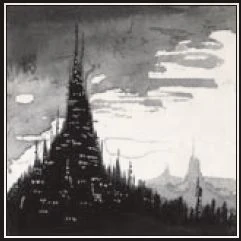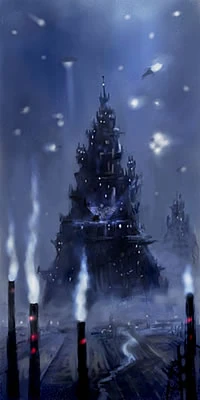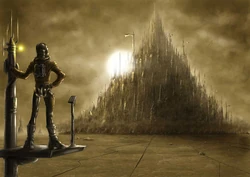"New to the hive my noble sir? No, don’t take me amiss! I’m here to help you, see? Outworlder are we? I can tell of course, not just the accent you understand, or the dress. Not used to the crowds are we sir? Getting buffeted and pushed along like that? Confused? Lost? Why if I hadn’t found you you’d be dipped and clipped in the blink of a scarab’s eye! You’ll feel better out of the press, come along, this isn’t a safe level you know?! What a fine specimen you are sir, if you don’t mind me saying… ‘long of limb and clean of skin’ as we say in the inhumation business… this way sir, down here, just one more stairwell… I know some friends of mine that will take to you right off, well, parts of you anyway..."
- — Vargo "Redjack" Heit, Hive Sibellus Viscerator

A Hive World


Another view of a Hive City
A Hive World is the most populous type of Imperial planet, of which there are approximately 32,380 currently catalogued by the Administratum in the Imperium of Man. The populations of these planets are so great that the people live in huge urban arcologies called hive cities, truly immense, self-contained, many-layered structures that reach high into the sky, each housing billions of individuals. Hive Worlds often provide much-needed industrial labour, their manufactoria producing mountains of war materiel and other goods to meet the Imperial tithe's demands. Most Hive Worlds started out as relatively hospitable places to live but have become severely polluted, the areas outside the hives reduced to ash wastes or radioactive desert by the never-ceasing industry of the great cities. Equally dangerous can be the hives themselves. The crime-ridden, poverty-stricken areas, almost always found in the most polluted and decrepit lower levels of the under-hive, are home to violent gangs, criminals and assorted scum as well as mutants and heretical cults who hide there from the authorities. It has been said that the sacrifice of over a million Imperial soldiers is worth "one day's Hive World production" in weapons and armour.
Perhaps even more valuable is what at first glance seems to be a byproduct of the monolithic hive city's design. The population of any given world approximately doubles every 100 years. With each hive housing between 10 to 100 billion people and 5 to 20 hives per planet, the sheer number of Imperial citizens on a Hive World is staggering. And each of those citizens is a potential soldier for the Emperor's already uncountably vast armies. Hives manufacture far more than mere steel and silica; they are vast factories for the most useful possible resource, people. Almost every recruit into the Imperial Guard from a Hive World will already know how to handle a weapon. Hive Worlds also serve to populate newly discovered planets. Imperial citizens are gathered from various Hive Worlds (willingly or unwillingly) by the Administratum and shipped off to distant colonies first discovered by the Adeptus Mechanicus' Explorator fleets.
In common with most other Imperial worlds, Hive Worlds are often based on a very obvious class system, with a ruling noble class and a bureaucratic middle class, although with populations so tightly packed there always develops a lower working class that often fuels violent street gangs. As can be expected, the upper classes are situated in the affluent upper areas of the hive cities, whilst the middle classes are situated in the middle areas,and the working classes are packed together in the lower areas. The very bottom sections of a hive city, the Underhive, are often areas where the underclasses and criminals are sent to be forgotten about and anarchy rules.
Some extensively developed Hive Worlds do not even consist of various enclosed arcologies surrounded by wasteland, jungle, ice, or plains. These Hive Worlds are completely urbanised and stacked with hundreds of layers of arcologies, covering the entirety of the planet, effectively becoming an ecumenopolis. Terra is an example of this type of "Super Hive World".
Notable Hive Worlds
| Planet Name | Segmentum | Sector | Subsector | System | Population |
| Arcadia | Unknown | Unknown | Unknown | Unknown | Unknown |
| Armageddon | Segmentum Solar | Armageddon Sector | Armageddon Sub-sector | Armageddon System | Unknown |
| Aurelia | Segmentum Ultima | Korianis Sector | Sub-sector Aurelia | Aurelian System | Unknown |
| Avellorn | Unknown | Unknown | Unknown | Unknown | Unknown |
| Coronis Agathon | Unknown | Unknown | Unknown | Unknown | 120,000,000,000 |
| Gehenna Prime | Unknown | Unknown | Unknown | Gehenna System | Unknown |
| Ichar IV | Ultima Segmentum | Unknown | Unknown | Ichar System | 500,000,000,000 |
| Ironfound | Unknown | Unknown | Unknown | Unknown | Unknown |
| Kado | Unknown | Unknown | Unknown | Unknown | Unknown |
| Lastrati | Unknown | Unknown | Unknown | Unknown | Unknown |
| Medusa V | Ultima Segmentum | Unknown | Unknown | Medusa System | None |
| Meridian | Ultima Segmentum | Korianis Sector | Sub-sector Aurelia | Unknown | 32,000,000,000 |
| Minea | Ultima Segmentum | Unknown | Unknown | Unknown | 154,000,000,000 |
| Mordian | Segmentum Obscurus | Unknown | Unknown | Mordian System | Unknown |
| Necromunda | Segmentum Solar | Unknown | Unknown | Necromunda System | Unknown |
| Scintilla | Segmentum Obscurus | Calixis Sector | Golgenna Reach | Scintilla System | 25,000,000,000 |
| Terra | Segmentum Solar | Sector Solar | Sol Sub-sector | Sol System | Unknown |
| Temperis | Segmentum Pacificus | Unknown | Unknown | Cabulis System | Unknown |
| Vanaheim | Unknown | Unknown | Unknown | Unknown | Unknown |
| Verghast | Segmentum Pacificus | Sabbat Worlds | Unknown | Unknown | Unknown |
Sources
- Dark Heresy: Core Rulebook (RPG), pg. 249
- Dark Heresy: Inquisitor's Handbook (RPG), pg. 108
- Warhammer 40,000: Rulebook (5th Edition)
- Necropolis (Novel) by Dan Abnett
- Helsreach (Novel) by Aaron Dembski-Bowden
- Hidden Depths (Short Story) by Sandy Mitchell
